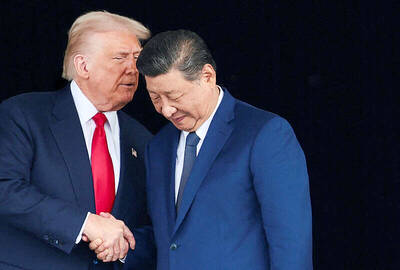The China Coast Guard has seized control of a disputed reef near a major Philippine military outpost in the South China Sea, Beijing’s state media said, adding to longstanding territorial tensions with Manila.
Beijing claims sovereignty over almost all of the South China Sea and has waved away competing assertions from other countries as well as an international ruling that its position has no legal basis.
China and the Philippines have engaged in months of confrontations in the contested waters, and Manila is taking part in sweeping joint military drills with the US which Beijing has slammed as destabilizing.

Photo: AFP/PHILIPPINE COAST GUARD/BUREAU OF FISHERIES AND AQUATIC RESOURCES (PCG/BFAR)
The Chinese coast guard “implemented maritime control” over the Tiexian Reef (鐵線礁), also known as Sandy Cay Reef, during the middle of April, state broadcaster China Central Television (CCTV) reported on Saturday.
The tiny sandbank, part of the Spratly Islands (Nansha Islands, 南沙群島), near Thitu Island (Jhongye Island, 中業島), also called Pagasa and the site of a Philippine military facility.
CCTV said the coast guard landed on the reef to “exercise sovereignty and jurisdiction,” carry out an “inspection” and “collect video evidence regarding the illegal activities of the Philippine side.”
The broadcaster published a photograph of five black-clad people standing on the uninhabited reef as a dark inflatable boat bobbed in the nearby water.
Another showed four coast guard officials posing with a Chinese flag on the reef’s white surface, in what CCTV described as a “vow of sovereignty.”
The Financial Times quoted an unnamed Philippine maritime official as saying that the China Coast Guard left after unfurling the flag.
There do not appear to be any signs that China has permanently occupied the reef or has built a structure on it.
Philippine forces are present on Thitu Island and Manila inaugurated a coast guard monitoring base there in 2023 to counter what it describes as Chinese aggression.
On Monday last week, the Philippine and US militaries launched three weeks of annual joint exercises called “Balikatan,” or “shoulder to shoulder,” which would include an integrated air and missile defense simulation for the first time.
Beijing said the maneuvers “undermine regional strategic stability” and accused Manila of “collusion with countries outside the region.”

CALL FOR SUPPORT: President William Lai called on lawmakers across party lines to ensure the livelihood of Taiwanese and that national security is protected President William Lai (賴清德) yesterday called for bipartisan support for Taiwan’s investment in self-defense capabilities at the christening and launch of two coast guard vessels at CSBC Corp, Taiwan’s (台灣國際造船) shipyard in Kaohsiung. The Taipei (台北) is the fourth and final ship of the Chiayi-class offshore patrol vessels, and the Siraya (西拉雅) is the Coast Guard Administration’s (CGA) first-ever ocean patrol vessel, the government said. The Taipei is the fourth and final ship of the Chiayi-class offshore patrol vessels with a displacement of about 4,000 tonnes, Lai said. This ship class was ordered as a result of former president Tsai Ing-wen’s (蔡英文) 2018

‘SECRETS’: While saying China would not attack during his presidency, Donald Trump declined to say how Washington would respond if Beijing were to take military action US President Donald Trump said that China would not take military action against Taiwan while he is president, as the Chinese leaders “know the consequences.” Trump made the statement during an interview on CBS’ 60 Minutes program that aired on Sunday, a few days after his meeting with Chinese President Xi Jinping (習近平) in South Korea. “He [Xi] has openly said, and his people have openly said at meetings, ‘we would never do anything while President Trump is president,’ because they know the consequences,” Trump said in the interview. However, he repeatedly declined to say exactly how Washington would respond in

WARFARE: All sectors of society should recognize, unite, and collectively resist and condemn Beijing’s cross-border suppression, MAC Minister Chiu Chui-cheng said The number of Taiwanese detained because of legal affairs by Chinese authorities has tripled this year, as Beijing intensified its intimidation and division of Taiwanese by combining lawfare and cognitive warfare, the Mainland Affairs Council (MAC) said yesterday. MAC Minister Chiu Chui-cheng (邱垂正) made the statement in response to questions by Democratic Progressive Party (DPP) Legislator Puma Shen (沈柏洋) about the government’s response to counter Chinese public opinion warfare, lawfare and psychological warfare. Shen said he is also being investigated by China for promoting “Taiwanese independence.” He was referring to a report published on Tuesday last week by China’s state-run Xinhua news agency,

‘ADDITIONAL CONDITION’: Taiwan will work with like-minded countries to protect its right to participate in next year’s meeting, the foreign ministry said The US will “continue to press China for security arrangements and protocols that safeguard all participants when attending APEC meetings in China,” a US Department of State spokesperson said yesterday, after Beijing suggested that members must adhere to its “one China principle” to participate. “The United States insists on the full and equal participation of all APEC member economies — including Taiwan — consistent with APEC’s guidelines, rules and established practice, as affirmed by China in its offer to host in 2026,” the unnamed spokesperson said in response to media queries about China putting a “one China” principle condition on Taiwan’s